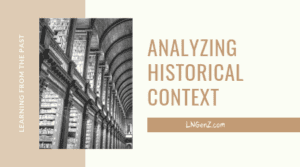-
June 2025
-
February 2025
-
January 2025
- MLK Day and Donald Trump’s Inauguration Fall on the Same Day – Lesson
- MLK Day and Donald Trump’s Inauguration Fall on the Same Day – Quiz
- The Evolution and Revolution of Donald Trump – Lesson
- The Evolution and Revolution of Donald Trump – Quiz
- Everything You Need to Know About the Presidential Inauguration – Lesson
- Everything You Need to Know About the Presidential Inauguration – Quiz
-
July 2024
- Biden Signs 10-Year Support Pact with Ukraine – Lesson
- Biden Signs 10-Year Support Pact with Ukraine – Quiz
- Microsoft Cloud Outage Causes International Chaos – Lesson
- Microsoft Cloud Outage Causes International Chaos – Quiz
- The First Amendment Odyssey of Julian Assange – Lesson
- The First Amendment Odyssey of Julian Assange – Quiz
- JD Vance Delivered an Inspiring Speech at the RNC – Lesson
- JD Vance Delivered an Inspiring Speech at the RNC – Quiz
- A Surprising Shift in US Migration Trends – Lesson
- A Surprising Shift in US Migration Trends – Quiz
- Young Americans Have No Faith in the Nation’s Future – Lesson
- Young Americans Have No Faith in the Nation’s Future – Quiz
-
June 2024
-
May 2024
- Blinken Visits Europe: Two Issues Dominated – Lesson
- Blinken Visits Europe: Two Issues Dominated – Quiz
- Can Ukraine Defeat Russia? – Lesson
- Can Ukraine Defeat Russia? – Quiz
- America’s Doomsday Plane Gets a Makeover – Lesson
- America’s Doomsday Plane Gets a Makeover – Quiz
- California Naturalizes About 155,000 New Citizens – Lesson
- California Naturalizes About 155,000 New Citizens – Quiz
- American Higher Education Struggles to Remain Competitive – Lesson
- American Higher Education Struggles to Remain Competitive – Quiz
- Police Forces Finally See a Post-Floyd Rebound – Lesson
- Police Forces Finally See a Post-Floyd Rebound – Quiz
- Esports – The Sport of Competitive Gaming – Lesson
- Esports – The Sport of Competitive Gaming – Quiz
- College Grads Leaving California for Greener – and Cheaper – Pastures – Lesson
- College Grads Leaving California for Greener – and Cheaper – Pastures – Quiz
- Mail Theft and Crimes Against Postal Workers Rising – Lesson
- Mail Theft and Crimes Against Postal Workers Rising – Quiz
- Biden Sharply Raises Tariffs on Chinese EVs, Steel – Lesson
- Biden Sharply Raises Tariffs on Chinese EVs, Steel – Quiz
-
April 2024
-
March 2024
- Biden Suspends Approvals for Natural Gas Exports – Lesson
- Biden Suspends Approvals for Natural Gas Exports – Quiz
- Super Tuesday: The Biggest Day in Primary Voting – Lesson
- Super Tuesday: The Biggest Day in Primary Voting – Quiz
- In Texas, Border Crisis Fuels Support for Independence – Lesson
- In Texas, Border Crisis Fuels Support for Independence – Quiz
- NATO Membership the Goal for Countries Fearing Putin’s Grasp – Lesson
- NATO Membership the Goal for Countries Fearing Putin’s Grasp – Quiz
- US Soldiers and the New War on Weight – Lesson
- US Soldiers and the New War on Weight – Quiz
- Trump Turmoil: Hits and Misses in the Legal Arena – Lesson
- Trump Turmoil: Hits and Misses in the Legal Arena – Quiz
- Cows on Trial in New York – Lesson
- Cows on Trial in New York – Quiz
-
February 2024
- Republicans Rally Behind Texas Governor Greg Abbott at the Border – Lesson
- Republicans Rally Behind Texas Governor Greg Abbott at the Border – Quiz
- Texas Declares Border Invasion – Can They Do That? – Lesson
- Texas Declares Border Invasion – Can They Do That? – Quiz
- Secretary of Defense Lloyd Austin Was in Hospital – And No One Knew – Lesson
- Secretary of Defense Lloyd Austin Was in Hospital – And No One Knew – Quiz
- Leap Year – The Four-Year Phenomenon – Lesson
- Leap Year – The Four-Year Phenomenon – Quiz
-
December 2023
-
November 2023
-
October 2023
- The Biden Impeachment Inquiry – Lesson
- The Biden Impeachment Inquiry – Quiz
- Israel vs Hamas: One Week in and Still at War – Lesson
- Israel vs Hamas: One Week in and Still at War – Quiz
- 2023 Nobel Prizes Announced – Lesson
- 2023 Nobel Prizes Announced – Quiz
- Trump Ordered Not to Mention Case Against Him – But Will It Last? – Lesson
- Trump Ordered Not to Mention Case Against Him – But Will It Last? – Quiz
-
September 2023
-
August 2023
-
July 2023
-
May 2023
-
February 2023
-
December 2022
-
November 2021
-
September 2022
-
August 2022
- The US Visits Taiwan Again – What Impact Will It Make? – Lesson
- The US Visits Taiwan Again – What Impact Will It Make? – Quiz
- Cold Showers and Hot Days: Europe Limits People’s Energy Use – Lesson
- Cold Showers and Hot Days: Europe Limits People’s Energy Use – Quiz
- Hidden Art Is Being Discovered Around the World – Lesson
- Hidden Art Is Being Discovered Around the World – Quiz
-
July 2022
- Last WWII Medal of Honor Recipient Will ‘Lie in State’ at US Capitol – Lesson
- Last WWII Medal of Honor Recipient Will ‘Lie in State’ at US Capitol – Quiz
- Canada and Denmark Make a Deal over Disputed Arctic Island – Lesson
- Canada and Denmark Make a Deal over Disputed Arctic Island – Quiz
- Texas Schools Spark Debate: What Should Kids Wear in Class? – Lesson
- Texas Schools Spark Debate: What Should Kids Wear in Class? – Quiz
-
June 2022
- New York Court Says: An Elephant is Not a Human – Lesson
- New York Court Says: An Elephant is Not a Human – Quiz
- Finance Classes at School – A New Trend? – Lesson
- Finance Classes at School – A New Trend? – Quiz
- NASA Will Study UFOs for the First Time – Lesson
- NASA Will Study UFOs for the First Time – Quiz
- New York City Removes Last Payphone – Or Does It? – Lesson
- New York City Removes Last Payphone – Or Does It? – Quiz
- US Hosts ‘Summit of the Americas’ – Lesson
- US Hosts ‘Summit of the Americas’ – Quiz
- The National Spelling Bee – A Time-Honored Tradition – Lesson
- The National Spelling Bee – A Time-Honored Tradition – Quiz
- Queen Elizabeth Marks 70 Years on Throne with Platinum Jubilee – Lesson
- Queen Elizabeth Marks 70 Years on Throne with Platinum Jubilee – Quiz
- Lifeguard Shortage Could Limit Summer Swimming – Lesson
- Lifeguard Shortage Could Limit Summer Swimming – Quiz
-
May 2022
- American Artist Warhol’s Painting Sells for Record Price – Lesson
- American Artist Warhol’s Painting Sells for Record Price – Quiz
- Western US Suffering From Harsh Drought – Lesson
- Western US Suffering From Harsh Drought – Quiz
- Time to Say Goodbye to Incandescent Lightbulbs? – Lesson
- Time to Say Goodbye to Incandescent Lightbulbs? – Quiz
- Tibetan Leader Visits Washington to Gain Support for His Culture – Lesson
- Tibetan Leader Visits Washington to Gain Support for His Culture – Quiz
-
April 2022
- Masks on Public Transport – Needed or Not? – Lesson
- Masks on Public Transport – Needed or Not? – Quiz
- Shanghai Under Strict Lockdown in ‘Zero-COVID’ China – Lesson
- Shanghai Under Strict Lockdown in ‘Zero-COVID’ China – Quiz
- Are Roundabouts a Good or Bad Addition to US Cities? – Lesson
- Are Roundabouts a Good or Bad Addition to US Cities? – Quiz
- Is it Chicken Kiev or Kyiv? A Scrumptious Spelling Problem – Lesson
- Is it Chicken Kiev or Kyiv? A Scrumptious Spelling Problem – Quiz
- Ketanji Brown Jackson Confirmed as Next Judge to Join Supreme Court – Lesson
- Ketanji Brown Jackson Confirmed as Next Judge to Join Supreme Court – Quiz
- Gas Prices Rise Dramatically Across America – Lesson
- Gas Prices Rise Dramatically Across America – Quiz
- Washington, DC Celebrates 110 Years of Cherry Blossoms in the City – Lesson
- Washington, DC Celebrates 110 Years of Cherry Blossoms in the City – Quiz
- Billionaire Elon Musk Tries to Buy Twitter – Lesson
- Billionaire Elon Musk Tries to Buy Twitter – Quiz
- Meet Patron, Ukraine’s Mine-Sniffing ‘Hero’ Dog – Lesson
- Meet Patron, Ukraine’s Mine-Sniffing ‘Hero’ Dog – Quiz
- Top American Officials Visit Ukraine in Secret – Lesson
- Top American Officials Visit Ukraine in Secret – Quiz
-
March 2022
- Supply Chain Crisis: Are Pop-Up Sites the Answer? – Lesson
- Supply Chain Crisis: Are Pop-Up Sites the Answer? – Quiz
- Fare Evaders Beware: New York Mayor to Tackle Subway Crime? – Lesson
- Fare Evaders Beware: New York Mayor to Tackle Subway Crime? – Quiz
- Time’s Up For Switching Clocks? Congress Considers Daylight Saving – Lesson
- Time’s Up For Switching Clocks? Congress Considers Daylight Saving – Quiz
- Ukraine’s President Addresses Congress as War Persists – Lesson
- Ukraine’s President Addresses Congress as War Persists – Quiz
- No More Meat? New York Mayor Decrees Vegan Fridays for Schools – Lesson
- No More Meat? New York Mayor Decrees Vegan Fridays for Schools – Quiz
- Big Business Shuns Russia Over Ukraine Invasion – Lesson
- Big Business Shuns Russia Over Ukraine Invasion – Quiz
- ‘People’s Convoy’ Loops Around US Capital in COVID Protest – Lesson
- ‘People’s Convoy’ Loops Around US Capital in COVID Protest – Quiz
- From Train Robberies to Stores – US Sees a Rise in Crime – Lesson
- From Train Robberies to Stores – US Sees a Rise in Crime – Quiz
- President Biden Gives His First State of the Union Speech – Lesson
- President Biden Gives His First State of the Union Speech – Quiz
-
February 2022
- Ukraine War Continues as Peace Talks Begin – Lesson
- Ukraine War Continues as Peace Talks Begin – Quiz
- US States Say Farewell to COVID Rules – Lesson
- US States Say Farewell to COVID Rules – Quiz
- Russia Launches Invasion of Ukraine – Lesson
- Russia Launches Invasion of Ukraine – Quiz
- Feuds Erupt as States Redraw Voting Maps – Lesson
- Feuds Erupt as States Redraw Voting Maps – Quiz
- Monobob Makes Olympic Debut – Lesson
- Monobob Makes Olympic Debut – Quiz
- Canadian Truckers Stage Major Protest Against COVID Laws – Lesson
- Canadian Truckers Stage Major Protest Against COVID Laws – Quiz
- U.S. Sends Troops to Europe as Ukraine-Russia Tensions Rise – Lesson
- U.S. Sends Troops to Europe as Ukraine-Russia Tensions Rise – Quiz
- Winter Olympics Begin in Beijing Amid Calls for Boycott – Lesson
- Winter Olympics Begin in Beijing Amid Calls for Boycott – Quiz
- Afghanistan Faces a ‘Tsunami of Hunger’ Under the Taliban – Lesson
- Afghanistan Faces a ‘Tsunami of Hunger’ Under the Taliban – Quiz
- Dealing With Omicron: COVID Rules Around the World – Lesson
- Dealing With Omicron: COVID Rules Around the World – Quiz
-
January 2022
- Teen Pilot Becomes Youngest Girl to Fly Solo Around the World – Lesson
- Teen Pilot Becomes Youngest Girl to Fly Solo Around the World – Quiz
- No More Meat and Potatoes? Supply Down and Prices Up – Lesson
- No More Meat and Potatoes? Supply Down and Prices Up – Quiz
- Flight Confusion as 5G Causes Safety Worries – Lesson
- Flight Confusion as 5G Causes Safety Worries – Quiz
- English Translations on French ID Cards? Some say ‘Non!’ – Lesson
- English Translations on French ID Cards? Some say ‘Non!’ – Quiz
- Omicron: Did COVID Catch the Common Cold? – Lesson
- Omicron: Did COVID Catch the Common Cold? – Quiz
- Five Countries Agree: Nuclear War Must Be Avoided – Lesson
- Five Countries Agree: Nuclear War Must Be Avoided – Quiz
- Enes Kanter’s American Dream Come True – Lesson
- Enes Kanter’s American Dream Come True – Quiz
- U.S. Bans Products Linked to Uighur Slavery – Lesson
- U.S. Bans Products Linked to Uighur Slavery – Quiz
- Time Capsules Found in Base of Robert E. Lee Statue – Lesson
- Time Capsules Found in Base of Robert E. Lee Statue – Quiz
-
December 2021
- Russia and US Lock Horns Over Ukraine Border – Lesson
- Russia and US Lock Horns Over Ukraine Border – Quiz
- US Military Starts New UFO Research Group – Lesson
- US Military Starts New UFO Research Group – Quiz
- Omicron COVID Strain Comes Out of South Africa – Lesson
- Omicron COVID Strain Comes Out of South Africa – Quiz
-
November 2021
- La Niña Weather Patterns May Affect the US This Winter – Lesson
- La Niña Weather Patterns May Affect the US This Winter – Quiz
- Dads on Duty Help Out at Louisiana High School – Lesson
- Dads on Duty Help Out at Louisiana High School – Quiz
- The Price of Thanksgiving Goes Up in 2021 – Lesson
- The Price of Thanksgiving Goes Up in 2021 – Quiz
- Airlines Struggle with Flights Ahead of the Holidays – Lesson
- Airlines Struggle with Flights Ahead of the Holidays – Quiz
-
October 2021
- Crisis and Kidnappings in Haiti – Lesson
- Crisis and Kidnappings in Haiti – Quiz
- US Feels Effects of Computer Chip Shortage – Lesson
- US Feels Effects of Computer Chip Shortage – Quiz
- California Oil Spill Investigations – Lesson
- California Oil Spill Investigations – Quiz
- Michigan Governor Vows to Fix Lead-Infected Water Supply – Lesson
- Michigan Governor Vows to Fix Lead-Infected Water Supply – Quiz
- Nobel Prize Winners Announced – Lesson
- Nobel Prize Winners Announced – Quiz
- COVID and School – Rules Vary Across the Nation – Lesson
- COVID and School – Rules Vary Across the Nation – Quiz
- Toilet Paper Shortage 2.0? – Lesson
- Toilet Paper Shortage 2.0? – Quiz
- A Very Merry COVID Homecoming? – Lesson
- A Very Merry COVID Homecoming? – Quiz
- Merck COVID Pill – A New Way to Treat the Virus? – Lesson
- Merck COVID Pill – A New Way to Treat the Virus? – Quiz
- Eruptions at La Palma and Kilauea Volcanoes – Lesson
- Eruptions at La Palma and Kilauea Volcanoes – Quiz
-
September 2021
- US Joins UK and Australia in ‘AUKUS’ Defense Deal – Lesson
- US Joins UK and Australia in ‘AUKUS’ Defense Deal – Quiz
- Rules Change for Travelers to the US – Lesson
- Rules Change for Travelers to the US – Quiz
- Is There a Crisis at the Southern Border? – Lesson
- Is There a Crisis at the Southern Border? – Quiz
- What’s Going On With COVID-19? – Lesson
- What’s Going On With COVID-19? – Quiz
- Biden Announces 6-Step COVID Plan – Lesson
- Biden Announces 6-Step COVID Plan – Quiz
- Private Rescue Missions in Afghanistan – Lesson
- Private Rescue Missions in Afghanistan – Quiz
- China’s Crackdown on Video Games – Lesson
- China’s Crackdown on Video Games – Quiz
-
August 2021
- US Military Has Left Afghanistan – But What About Those Left Behind? – Lesson
- US Military Has Left Afghanistan – But What About Those Left Behind? – Quiz
- Hurricane Ida Tests New Orleans – Lesson
- Hurricane Ida Tests New Orleans – Quiz
- Records Set for Paralympic Games – Lesson
- Records Set for Paralympic Games – Quiz
- Storms in Tennessee and Northeast Cause Floods – Lesson
- Storms in Tennessee and Northeast Cause Floods – Quiz
Washington, DC Celebrates 110 Years of Cherry Blossoms in the City – Lesson
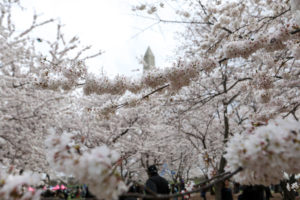
(Photo by Yasin Ozturk/Anadolu Agency via Getty Images)
A gift from Japan that has been cherished for over a century.
It’s spring again, and with the season comes the National Cherry Blossom Festival in Washington, DC. As a token of friendship, Japan gifted the United States 6,000 Yoshino cherry blossom trees in 1912. As a result, the beautiful plants can be found in both DC and New York. Every year, around 1.5 million people head to the capital to view the beautiful trees in full bloom. This year marks the 110th anniversary of the planting.
The National Cherry Blossom Festival
The vivaciously colored blossoms represent the beginning of spring along with hope and renewal. The trees were planted in a circle surrounding the Tidal Basin, which is a is a man-made reservoir. The trees are in the company of the Jefferson Memorial, Washington Monument, and Martin Luther King, Jr. Memorial.
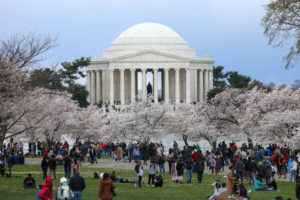
(Photo by Yasin Ozturk/Anadolu Agency via Getty Images)
In 1927, school children re-enacted the initial planting, holding the first unofficial “festival.” Later, civic groups helped expand the annual practice, and in 1935, the first official National Cherry Blossom Festival was held. It became a huge hit. Not only are these flowers a gorgeous sight to see, but the celebration includes art and cultural events.
The festival continued to grow over the years, and now it lasts for 16 days. It begins toward the end of March and continues into mid-April.
“We continue to ensure that we remember where this gift came from and the fact that it’s an example of peace and international friendship,” said president of the National Cherry Blossom Festival, Diana Mayhew.
The Gift
Known as sakura in Japan, cherry blossom trees are a symbol of hope and renewal. However, they are only in full bloom for about one week before the final petals fall. The Japanese admire the short-lived blossoms as a symbol of the fleeting nature of life. During the brief flowering season, they hold flower-watching parties called hanami. It is a sacred time in Japan, and those in Washington, DC understand why.
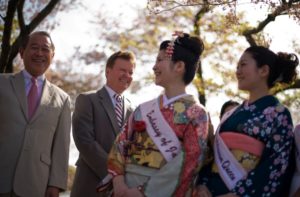
(Photo By Tom Williams/Roll Call/Getty Images)
In 1912, the Japanese gifted the US with 6,000 Yoshino cherry blossom trees. It began with a writer for National Geographic named Eliza Scidmore, who visited Japan in 1885. She was in awe of the plant’s beauty and wished to see them in Washington, DC. So she began a campaign, writing to anyone she could until she got the attention of the first lady, Helen Louise Taft. Taft ordered the Army to plant some cherry blossom trees in Washington. But unfortunately, they could only get around 80 or 90 of the plants from Pennsylvania.
A Japanese biochemist named Jokichi Takamine happened to be in Washington, and he agreed the trees were an excellent idea. Takamine asked the Mayor of Tokyo whether he would be willing to donate some as a gift. The mayor agreed, but when the plants arrived in 1909, a problem was discovered. They were found to be diseased and infested with insects and nematodes. Unfortunately, to protect the local ecosystem, the tress had to be burned. Only a few were kept for study.
Despite this setback, Japan agreed to replace the trees. Of the 6,000 gifted trees that arrived in 1912, 3,000 went to New York and the other 3,000 to Washington, DC.
Helen Taft and the wife of the Japanese ambassador, the Viscountess Chinda, planted two of the trees on the Tidal Basin’s northern bank. This marked the beginning of the American cherry blossom tradition. Since then, lots of cultural exchanges have taken place to celebrate this sign of friendship between the two countries.
The Relationship Between the US and Japan
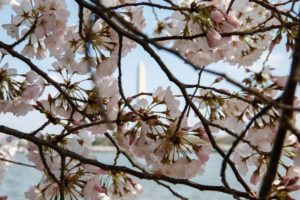
(Photo by Yasin Ozturk/Anadolu Agency/Getty Images)
Since the early 1950s, the United States and Japan have been allies. During World War II, Japan fought with the Axis Powers against the Allies. After Japan attacked Pearl Harbor, the US joined the Allies and sent soldiers to fight throughout the Pacific region. The Axis lost the war, and Japan surrendered after the US dropped two atomic bombs on the cities of Hiroshima and Nagasaki.
Following the end of the war in 1945, America occupied Japan for seven years, helping rebuild it into a new version of the country. Japan and the US began a strong friendship. The US-Japan Security Treaty was signed in 1960 and expanded in 2015. Today, the two nations work together on regional issues in Asia, economics, and trade.
The strong covenant between the US and Japan is represented every spring when the cherry blossom trees bloom in Washington, DC.
